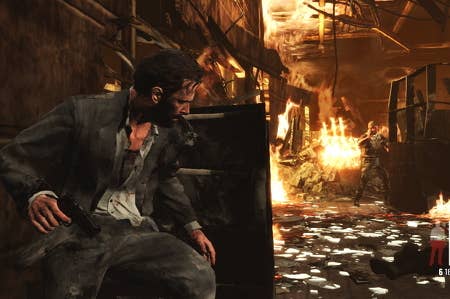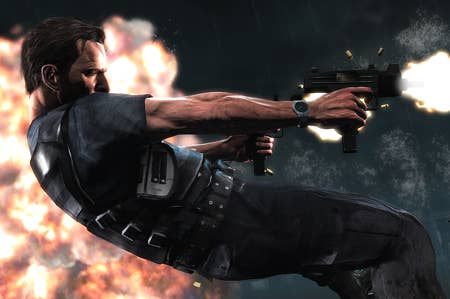Critical Consensus: Max Payne 3
The film noir "hero" returns but does story overwhelm gameplay?
It's been eleven years since Finnish developer Remedy Entertainment first combined third-person shooting, pulp noir, and bullet time to make Max Payne; ten years since Remedy Entertainment sold the rights to the series to Rockstar Games' parent company Take-Two Interactive; nine years since Remedy returned for the follow-up, Max Payne 2: The Fall of Max Payne; eight years since Take-Two's then-CEO Jeffery Lapin confirmed Max Payne 3 was coming; three years since the official announcement that Rockstar was developing the game instead of Remedy, who had moved onto to the Alan Wake series.
In those three years, Max Payne 3 has seen its share of delays, being pushed back from late 2009, to 2010, to 2011, before finally receiving a release date of March 2012. Then Take-Two hit Max Payne 3 with one final delay, pushing it back to this month in order to ensure that the game was "the highest quality, groundbreaking entertainment experience that is expected from our company." Rockstar is a studio that aims for perfection with each title and after its long development history, fans would accept nothing less of Max Payne 3.
So did Rockstar deliver on Max's latest outing?
According to Polygon's Arthur Gies, Rockstar has given fans one of the best games is its long history. He finds the strength of the game in its story and presentation, with Rockstar creating a fully-realized world by focusing on the little details.
"Max Payne 3 might not be the most successful cinematic experience Rockstar has ever made, but it's easily its best game," he says in his 9 out of 10 review. "In some ways, Max Payne 3 is indicative of the worst of Rockstar's indulgences, particularly in the story. While there's characterization in Max Payne 3's noir-infused conspiracy, it's composed of sketches of people that can devolve into caricature."
"Rockstar is reliant on the story to keep players engaged. How effective a gambit this is will hinge on your response to Max's hardboiled schtick"
"Max Payne 3 has mood and tone coming out of its ears. But the story often bleeds out any sense of heft or weight from its big beats well in advance. It wouldn't be so obvious in other games. But Max Payne 3 is so ... conscientious about everything else."
"It starts with little things. From action to cutscene, Max is always holding the weapons he had a second ago. If he's carrying a rifle or shotgun and needs his hands, he'll set it down on something and pick it back up. Even during gameplay, he'll carry that rifle in his offhand when it isn't selected, and if you go two-fisted with the handguns, he drops it," Gies adds.
"This doesn't affect the basic play fundamentals of Max Payne 3 much, but it helps to create a cohesive world that you understand. It's involving. It's why presentation really matters, and it's the most Rockstar has gotten it."
That presentation extends to Max Payne 3's handling of the extreme violence the protagonist finds himself in. Powered by Rockstar's Rage engine and Euphoria physics, Max Payne 3's bullets shred bodies in stark detail. It reaches a level of hyper-violence that's usually found in survival horror games like Dead Space and Resident Evil.

"Few games better document the journey of a bullet. As Max hurls himself through the air and into dangerous exposure, the game slows down long enough to reveal its subtle tricks. Every fight is a repeatable build-up of tension - you stick out your head, open fire and adjust your aim as soon the reticle appears - and then relief, marked by a faint on-screen blip that says you can stop pumping bullets into that particular guy. This is also illustrated, in a slightly more overt way, by gruesome explosions of blood and a discovery of true purpose for the Euphoria physics engine, which expertly conveys the horrible fate of body parts struck by metallic projectiles. Sometimes you're not sure whether to shake your head in disgust, or laugh at how damn cool it all looks," writes Joystiq's Ludwig Kietzmann, who gives the game 4.5 stars out of 5.
Edge also loves Rockstar's attention to detail, but finds the actual mechanics of the game "fairly straightforward". The reviewer notes that the game hinges completely on the story being told by Rockstar, leading to a score of 7 out of 10.
"Max Payne 3 is all about such details, its astonishing production values fashioning a world richer than a string of bowls and corridors designed to showcase Payne's athletic style of gunplay really needed to be. The first Payne game to be developed by Rockstar might hew closely to its predecessors in gameplay terms, but it's clear the New York-based publisher has brought the full force of its world-building skills, eye for cinematic flair and deep pockets to bear here."
"It's not that Max Payne 3's gameplay is substandard - far from it - but it's always firmly in the service of its overarching narrative"
"But get past the visual flair and grisly detail, and Max Payne's gunplay is fairly straightforward. From tutorial to credits, Max Payne 3 refuses to play with its core mechanics. This means that aside from the occasional on-rails section or slow-mo set-piece, Rockstar is reliant on the story to keep players engaged. How effective a gambit this is will hinge on your response to Max's hardboiled schtick. He's not exactly likeable, and while the plot dutifully conjures a series of cartoony villains even more hateful than he is, it suffers from the absence of a strong supporting cast - Payne's sidekick, Passos, might be handy in a gunfight, but he's certainly no Chloe, Elena or Sully," Edge continues, referring to the strong cast in Uncharted.
IGN's Daniel Krupa agrees that the gameplay comes second to the story being told by Rockstar, with specific praise being given to voice actor James McCaffrey's "nuanced" performance. He also compares Max Payne 3 to Naughty Dog's Uncharted series, but gives the former points for making its set pieces matter to the character instead of just looking pretty. Krupa's 9 out of 10 score ends up slightly higher than the game's Metacritic average of 88.
"It's not that Max Payne 3's gameplay is substandard - far from it - but it's always firmly in the service of its overarching narrative. Consequently, the game is heavily punctuated by cut scenes - some brief, some quite long. Ultimately, it's a trade-off, and if you buy into Max's plight, cut scenes become engrossing, and it's joy to see them bleed seamlessly into the furious action," says Krupa.
"However, the action set-pieces seem a little muted, especially when compared to, say, the spectacular recent capers of Nathan Drake. But this isn't necessarily a bad thing. In Uncharted 3: Drake's Deception, there's a well-known scene in which Sully and Drake must escape from a French château before it burns to the ground. It's exciting and adrenaline-inducing, but it doesn't really serve much purpose in terms of the game's narrative"

"A similar scene occurs in Max Payne 3; a building is set on fire and Max must escape before he is incinerated. But this isn't just eye-candy or glitzy spectacle. Admittedly, it's less exhilarating than Uncharted's equivalent scene but it's also has greater significance. Max has found himself at his lowest ebb inhabiting an environment quickly resembling hell - the metaphorical significance of which isn't lost on Max. This is when the game is at its strongest - when gameplay, character and narrative all wonderfully fuse and interplay."
Like Grand Theft Auto IV before it, Rockstar has added multiplayer to the Max Payne universe. According to GameInformer's Andrew Reiner, the game's multiplayer features are strong despite the franchise's single-player roots. Max Payne 3's Gang Wars mode is mentioned in multiple reviews as Rockstar's play at bringing single-player narrative into multiplayer combat.
"Max Payne may not seem like a franchise that lends itself well to multiplayer, but Rockstar has found a way to keep Bullet Time alive and well for deathmatching purposes, and uses it to anchor a robust offering of competitive modes," says Reiner.
"The same great gunplay from the campaign is replicated in the multiplayer modes, and immense depth is tied to the ranking system (with a level cap of 50) and slew of unlockable guns, skins, and items. Rockstar also provides a crew system that tracks world ranks, kill-to-death ratios, and first place finishes for each crew."

"Deathmatch and team deathmatch prove to be fun, grinder-like experiences with average lives lasting for 20 to 30 seconds. The coolest multiplayer mode offered is Gang Wars. This mode pits two teams against each other and incorporates story threads from the campaign to shape the five rounds. How a round ends dictates what the next objective will be, a design that keeps the battles fresh," he explains.
With a metascore similar to its predecessors, Max Payne 3 looks to be a worthy return for the series. While Xbox 360 and PlayStation 3 users can experience Max's trial and tribulations tomorrow, PC users will have to wait until May 29, 2012 to partake in his rampage across São Paulo, Brazil. Either way, Rockstar Games continues its streak of turning out amazing titles, even if Payne falls slightly short of the 9s and 10s that typically grace its Grand Theft Auto games.

